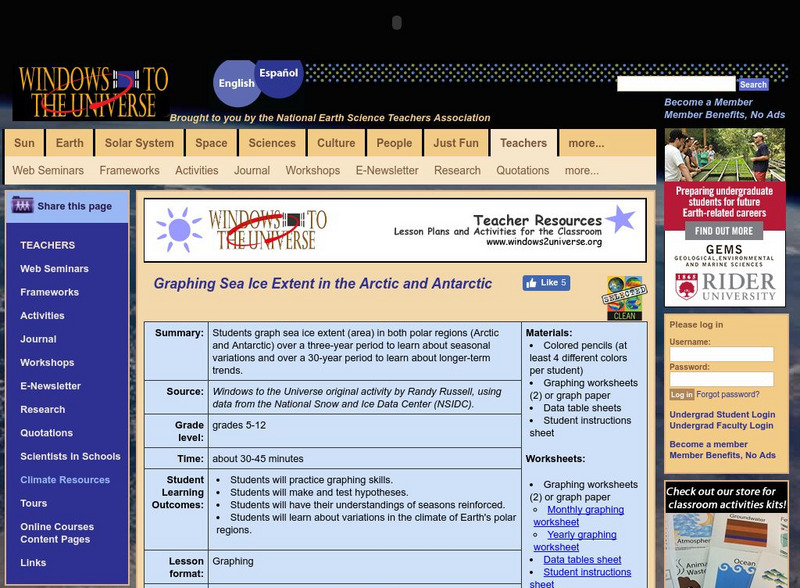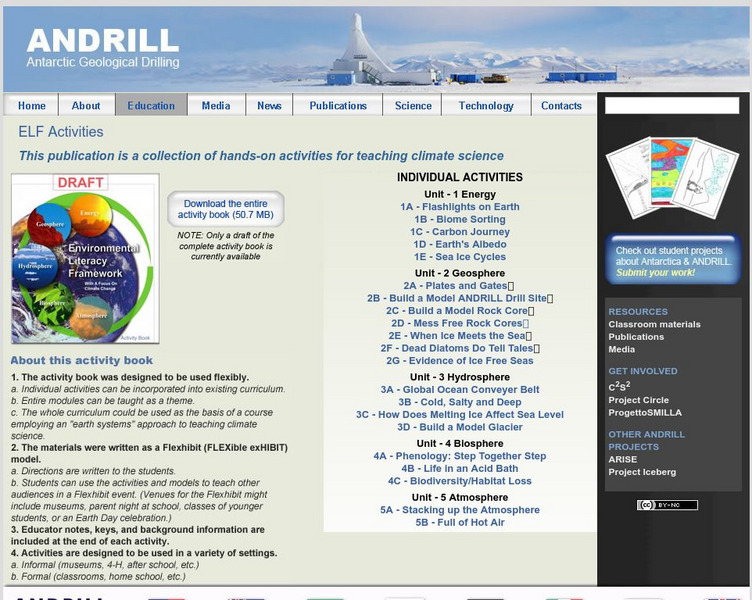Climate Literacy
Clean: Coral Bleaching: A White Hot Problem
Students investigate coral bleaching using water temperature data from the NOAA National Data Buoy Center. Then they learn about the habitat of corals, the stresses on coral populations, and the impact of increased sea surface...
Climate Literacy
Clean: Climate Change and Arctic Ecosystems
Students learn about how climate change is affecting the Arctic ecosystem, and then investigate how this change is impacting polar bear populations. Students analyze maps of Arctic sea ice, temperature graphs, and polar bear population...
Climate Literacy
Clean: Climate Change and Ecosystems
Students research the inter-dependencies among plants and animals in an ecosystem and explore how climate change affects those relationships and the ecosystem as a whole.
Climate Literacy
Clean: Person on the Street (Pos) Interview About Climate Science
A media project where young scholars create a video that documents unrehearsed interviews with "people on the street" about a specific question or issue in climate science.
Climate Literacy
Clean: Impacts of Topography on Sea Level Change
Students use web-based animations to explore the impacts of ice melt, specifically changes to sea level. They also use topographic maps to examine the relationship between topography and sea level change by mapping changing shorelines.
Science Education Resource Center at Carleton College
Serc: Greenhouse Effect Lab
Students measure temperature changes inside soda bottles filled with CO2 and air as incandescent light is shined on them to model the Greenhouse Effect.
University of Colorado
University of Colorado: Hitting Home: Climate Change in Colorado [Zip]
Students examine and interpret varied observational data sets to determine whether climate change is occurring in Colorado.
Climate Literacy
Clean: Greenhouse Gas in a Bottle Demonstration
A simple demonstration that is quick and easy to setup and provides dramatic evidence of the effect on temperature of an atmosphere with increased carbon dioxide. [4 min]
National Association of Geoscience Teachers
Nagt: History of Climate Science
For this activity. students synthesize ideas and critically evaluate the current social perspectives of climate science and social decision-making.
National Earth Science Teachers Association
Windows to the Universe: Graphing the Extent of Sea Ice in Arctic and Antarctic
Students graph sea ice extent in both polar regions over a three-year period to learn about seasonal variations, and over a 30-year period to learn about longer-term trends.
National Earth Science Teachers Association
Windows to the Universe: Feeling the Heat
For this lesson students learn about the urban heat island effect by investigating which areas of their schoolyard have higher temperatures. Then they analyze data about how the number of heat waves in an urban area has increased over...
TeachEngineering
Teach Engineering: Carbon Cycles
Middle schoolers are introduced to the concept of energy cycles by learning about the carbon cycle. They will learn how carbon atoms travel through the geological (ancient) carbon cycle and the biological/physical carbon cycle. Students...
PBS
Nova: Extreme Ice
Students study how scientists monitor changes in Earth's glaciers, ice caps, and ice sheets. They investigate about glacier locations, glacial movement, and impacts of climate change on glaciers depending on the depth of research.
Other
Antarctic Geological Drilling: Environmental Literacy Framework Activities
An impressive collection of lessons on climate science and climate change. The entire book can be downloaded. As well, each lesson has its own page with some combination of background information, PowerPoints, images, maps, glossaries,...
Other
Alliance to Save Energy: Educator Lesson Plans
A series of teacher lesson plans for various grade levels. Topics pertain to insulation (among other things) and other energy conservation and energy efficiency topics. Can be easily adapted for a student project or lab investigation.
University Corporation for Atmospheric Research
Ucar: Co2: How Much Do You Spew?
Students analyze the energy consumption of a hypothetical household to determine the amount of carbon dioxide they are adding to the atmosphere each year.
National Earth Science Teachers Association
Windows to the Universe: Changing Planet: Melting Glaciers
Students sort photographs of glaciers and measure glacial retreat to observe how alpine glaciers have retreated over the past century. Includes a printable worksheet, links to relevant materials, and extension activities.
Other popular searches
- Global Warming Worksheet
- Global Warming Recycling
- Global Warming Activities
- Global Warming Ozone
- Global Warming Projects
- Global Warming Labs
- Global Warming Lesson Plans
- Global Warming Affects
- Geography Global Warming
- Global Warming and Trees
- Environment Global Warming
- Global Warming Research













